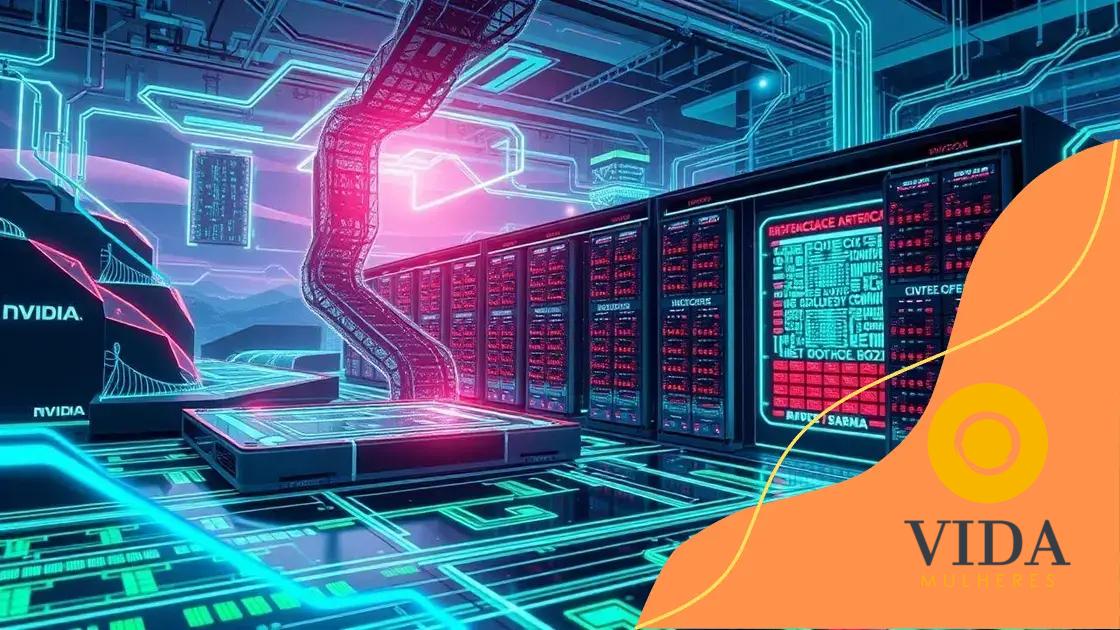Nvidia’s $500B commitment to AI infrastructure growth

Nvidia’s $500B commitment to AI infrastructure growth emphasizes enhancing advanced AI technologies, fostering global collaboration, addressing key challenges, and shaping the future of artificial intelligence across various industries.
Nvidia’s commitment to AI infrastructure is set to transform the tech industry as we know it. Have you ever wondered how such a massive investment could influence innovation and competition in the field? Let’s dive into the details.
Understanding Nvidia’s investment strategy
Nvidia’s investment strategy is comprehensive and forward-thinking. The company’s focus on expanding its capabilities in AI infrastructure is evident in its substantial funding commitments.
By allocating resources effectively, Nvidia aims to lead in the competitive landscape of technology.
Key Aspects of Nvidia’s Investment
Nvidia emphasizes several critical factors in its investment approach. These include:
- Long-term vision for AI technology
- Partnerships with leading tech firms
- Focus on sustainability and efficiency
- Investment in research and development
This strategy not only enhances performance but also positions Nvidia as a pioneer in the AI infrastructure sector. The company understands that to succeed, it must innovate and adapt continuously.
Strategic Partnerships
Another significant element is Nvidia’s strategic partnerships. Collaborations with companies such as Microsoft and Amazon Web Services expand their reach and capabilities.
These alliances enable shared resources and knowledge, leading to improved infrastructure solutions.
Nvidia’s approach ensures that its investments are not just financial but also strategic, paving the way for advancements in machine learning and deep learning technologies.
By fostering collaboration, they enhance their standing as a key player in the tech world.
In summary, Nvidia’s investment strategy is multifaceted, combining financial commitments with a vision for future AI development. By understanding these dynamics, stakeholders can appreciate the vast potential of Nvidia’s plans.
Impact on the global AI ecosystem

The impact of Nvidia’s investment on the global AI ecosystem is significant and far-reaching.
As one of the leaders in artificial intelligence, Nvidia’s strategies and innovations shape how industries use and integrate AI technologies.
Expansion of AI Applications
With Nvidia’s advancements, we see an expansion in various AI applications. These include:
- Enhanced machine learning capabilities
- More effective data analysis tools
- Innovative solutions for autonomous systems
- Transformations in cloud computing services
This expansion not only benefits tech companies but also influences sectors like healthcare, finance, and transportation.
The increased accessibility of AI tools allows businesses of all sizes to leverage advanced technologies in meaningful ways.
Global Collaboration
Nvidia’s investments foster global collaboration among companies, researchers, and developers. Such partnerships help spread knowledge, resources, and best practices across borders.
This collaboration accelerates the pace of innovation and growth within the AI landscape.
As businesses work together, they are able to share different perspectives, which leads to advancements in AI research and development.
The ripple effect of Nvidia’s commitment not only transforms technology but also encourages a community of innovation among various stakeholders in the ecosystem.
In summary, Nvidia‘s investment significantly impacts the global AI ecosystem, enhancing application potential and fostering collaboration that drives continuous improvement and innovation in the field.
Key projects and partnerships
Nvidia’s impactful strategy includes a range of key projects and partnerships that enhance its position in the AI infrastructure landscape.
These collaborations not only broaden Nvidia’s capabilities but also drive innovation across various sectors.
Major Collaborations
Among the notable partnerships are:
- Collaboration with Microsoft on Azure AI capabilities.
- Working with Amazon Web Services to optimize cloud computing.
- Engagement with various universities to advance AI research.
- Partnership with leading automotive companies for autonomous vehicle technology.
These collaborations emphasize a shared goal of optimizing artificial intelligence applications and making AI more accessible to businesses and researchers alike.
Innovative Projects
Nvidia is known for several innovative projects that underpin its commitment to leading in AI technology:
- The development of Nvidia GPU Cloud for easy access to GPU-accelerated applications.
- Launching the Nvidia Triton Inference Server to improve machine learning model deployment.
- Creating Nvidia Omniverse for real-time 3D simulations
- Expanding efforts in edge computing to bring AI solutions directly to devices.
Through these projects, Nvidia exemplifies its ambition to not just participate in but redefine the scope of what is possible with AI technology.
Integrating varied approaches ensures they are at the forefront of innovation that addresses current and future challenges in the tech ecosystem.
Challenges in AI infrastructure development

The journey of developing AI infrastructure is filled with challenges that companies like Nvidia face.
As they strive to lead in this arena, understanding these obstacles is essential for future progress.
Scalability Issues
One major challenge is scalability. As AI models grow more complex and require more data and processing power, infrastructure must keep pace.
It’s critical for businesses to:
- Ensure sufficient computing resources are available
- Manage increased energy consumption efficiently
- Adapt to evolving technology demands
- Maintain cost-effectiveness throughout
These factors contribute to the difficulty of scaling AI solutions without compromising performance.
Data Management Challenges
Data management is another significant hurdle. The ability to effectively store, process, and analyze vast amounts of data is essential for AI. Companies must confront issues like:
- Data privacy and security regulations
- Ensuring data quality and accuracy
- Integrating disparate data sources
- Managing data biases that can skew AI outcomes
Addressing these concerns is vital for building reliable AI systems.
Moreover, the rapid pace of innovation means that infrastructure must constantly evolve.
AI technologies are not static; they require ongoing investment in new tools and processes to stay competitive.
By navigating these challenges head-on, organizations can set themselves up for success in a burgeoning AI landscape.
Future outlook for AI technology
The future outlook for AI technology appears bright, driven by rapid advancements and increasing investments.
As companies like Nvidia push the boundaries, numerous trends are emerging that will shape the landscape of artificial intelligence.
Advancements in Machine Learning
One major trend is the continual improvement of machine learning algorithms.
These advancements will allow systems to learn faster, process larger datasets, and deliver more accurate predictions. Key areas to watch include:
- Development of new neural network architectures
- Increased automation in training processes
- Enhanced interpretability of AI models
- Focus on unsupervised and semi-supervised learning techniques
As these technologies mature, they will enable more applications across various industries.
Integration with Other Technologies
The integration of AI with technologies like the Internet of Things (IoT) and blockchain will also be significant. This will create smarter systems that can analyze and process data in real-time.
Combining AI with IoT can lead to innovations such as:
- Smart cities with connected infrastructure
- Advanced healthcare solutions through remote monitoring
- Improved supply chain management
- Enhanced customer experiences through personalized services
As AI becomes further integrated, its impact will be felt in everyday life, streamlining processes and improving efficiencies.
In summary, the future of AI technology is poised for major breakthroughs.
With continued investment and research, we can expect transformative changes that will redefine how we interact with technology and each other.
FAQ – Frequently Asked Questions about Nvidia’s $500B Commitment to AI Infrastructure Growth
What is Nvidia’s investment in AI infrastructure?
Nvidia has committed $500 billion to enhance its AI infrastructure, aiming to lead advancements in artificial intelligence technology.
How does Nvidia’s investment impact the AI ecosystem?
Nvidia’s investment fosters innovation, drives scalability, and creates new opportunities for collaboration in the global AI ecosystem.
What challenges does Nvidia face in AI development?
Nvidia encounters challenges such as scalability, data management, and the need for ongoing advancements in AI technology.
What is the future outlook for AI technology?
The future of AI technology looks promising, with expected innovations and integrations that will transform industries and improve daily life.






